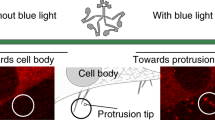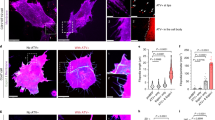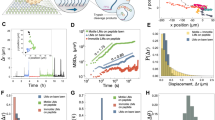Abstract
Cytoskeletal motors drive the transport of organelles and molecular cargoes within cells1 and have potential applications in molecular detection and diagnostic devices2,3. Engineering molecular motors with controllable properties will allow selective perturbation of mechanical processes in living cells and provide optimized device components for tasks such as molecular sorting and directed assembly3. Biological motors have previously been modified by introducing activation/deactivation switches that respond to metal ions4,5 and other signals6. Here, we show that myosin motors can be engineered to reversibly change their direction of motion in response to a calcium signal. Building on previous protein engineering studies7,8,9,10,11 and guided by a structural model12 for the redirected power stroke of myosin VI, we have constructed bidirectional myosins through the rigid recombination of structural modules. The performance of the motors was confirmed using gliding filament assays and single fluorophore tracking. Our strategy, in which external signals trigger changes in the geometry and mechanics of myosin lever arms, should make it possible to achieve spatiotemporal control over a range of motor properties including processivity, stride size13 and branchpoint turning14.
This is a preview of subscription content, access via your institution
Access options
Subscribe to this journal
Receive 12 print issues and online access
$259.00 per year
only $21.58 per issue
Buy this article
- Purchase on Springer Link
- Instant access to full article PDF
Prices may be subject to local taxes which are calculated during checkout



Similar content being viewed by others
References
Vale, R. D. The molecular motor toolbox for intracellular transport. Cell 112, 467–480 (2003).
Korten, T., Mansson, A. & Diez, S. Towards the application of cytoskeletal motor proteins in molecular detection and diagnostic devices. Curr. Opin. Biotechnol. 21, 477–488 (2010).
Goel, A. & Vogel, V. Harnessing biological motors to engineer systems for nanoscale transport and assembly. Nature Nanotech. 3, 465–475 (2008).
Liu, H. et al. Control of a biomolecular motor-powered nanodevice with an engineered chemical switch. Nature Mater. 1, 173–177 (2002).
Konishi, K., Uyeda, T. Q. & Kubo, T. Genetic engineering of a Ca2+ dependent chemical switch into the linear biomotor kinesin. FEBS Lett. 580, 3589–3594 (2006).
Nomura, A., Uyeda, T. Q. P., Yumoto, N. & Tatsu, Y. Photo-control of kinesin-microtubule motility using caged peptides derived from the kinesin C-terminus domain. Chem. Commun. 3588–3590 (2006).
Tsiavaliaris, G., Fujita-Becker, S. & Manstein, D. J. Molecular engineering of a backwards-moving myosin motor. Nature 427, 558–561 (2004).
Bryant, Z., Altman, D. & Spudich, J. A. The power stroke of myosin VI and the basis of reverse directionality. Proc. Natl Acad. Sci. USA 104, 772–777 (2007).
Park, H. et al. The unique insert at the end of the myosin VI motor is the sole determinant of directionality. Proc. Natl Acad. Sci. USA 104, 778–783 (2007).
Liao, J-C., Elting, M. W., Delp, S. L., Spudich, J. A. & Bryant, Z. Engineered myosin VI motors reveal minimal structural determinants of directionality and processivity. J. Mol. Biol. 392, 862–867 (2009).
Elting, M. W., Bryant, Z., Liao, J-C. & Spudich, J. A. Detailed tuning of structure and intramolecular communication are dispensable for processive motion of myosin VI. Biophys. J. 100, 430–439 (2011).
Menetrey, J., Llinas, P., Mukherjea, M., Sweeney, H. L. & Houdusse, A. The structural basis for the large powerstroke of myosin VI. Cell 131, 300–308 (2007).
Vilfan, A. Elastic lever-arm model for myosin V. Biophys. J. 88, 3792–3805 (2005).
Vilfan, A. Myosin V passing over Arp2/3 junctions: branching ratio calculated from the elastic lever arm model. Biophys. J. 94, 3405–3412 (2008).
Lee, L. K., Ginsburg, M. A., Crovace, C., Donohoe, M. & Stock, D. Structure of the torque ring of the flagellar motor and the molecular basis for rotational switching. Nature 466, 996–1000 (2010).
Roostalu, J. et al. Directional switching of the kinesin Cin8 through motor coupling. Science 332, 94–99 (2011).
Holmes, K. C., Schröder, R. R., Sweeney, H. L. & Houdusse, A. The structure of the rigor complex and its implications for the power stroke. Phil. Trans. R. Soc. Lond. B 359, 1819–1828 (2004).
Wells, A. L. et al. Myosin VI is an actin-based motor that moves backwards. Nature 401, 505–508 (1999).
Menetrey, J. et al. The structure of the myosin VI motor reveals the mechanism of directionality reversal. Nature 435, 779–785 (2005).
Anson, M., Geeves, M. A., Kurzawa, S. E. & Manstein, D. J. Myosin motors with artificial lever arms. EMBO J. 15, 6069–6074 (1996).
Gordon, A. M., Homsher, E. & Regnier, M. Regulation of contraction in striated muscle. Physiol. Rev. 80, 853–924 (2000).
Somlyo, A. P. & Somlyo, A. V. Signal transduction and regulation in smooth muscle. Nature 372, 231–236 (1994).
Wang, X. & Schwarz, T. L. The mechanism of Ca2+-dependent regulation of kinesin-mediated mitochondrial motility. Cell 136, 163–174 (2009).
Satoh, A. K., Li, B. X., Xia, H. & Ready, D. F. Calcium-activated Myosin V closes the Drosophila pupil. Curr. Biol. 18, 951–955 (2008).
Krementsov, D. N., Krementsova, E. B. & Trybus, K. M. Myosin V: regulation by calcium, calmodulin, and the tail domain. J. Cell Biol. 164, 877–886 (2004).
Trybus, K. M. et al. Effect of calcium on calmodulin bound to the IQ motifs of myosin V. J. Biol. Chem. 282, 23316–23325 (2007).
Parker, D., Bryant, Z. & Delp, S. L. Coarse-grained structural modeling of molecular motors using multibody dynamics. Cell. Mol. Bioeng. 2, 366–374 (2009).
Sweeney, H. L. et al. Kinetic tuning of myosin via a flexible loop adjacent to the nucleotide binding pocket. J. Biol. Chem. 273, 6262–6270 (1998).
Krementsova, E. B., Hodges, A. R., Lu, H. & Trybus, K. M. Processivity of chimeric class V myosins. J. Biol. Chem. 281, 6079–6086 (2006).
Zheng, J. Q. & Poo, M. M. Calcium signaling in neuronal motility. Annu. Rev. Cell Dev. Biol. 23, 375–404 (2007).
Yeh, B. J., Rutigliano, R. J., Deb, A., Bar-Sagi, D. & Lim, W. A. Rewiring cellular morphology pathways with synthetic guanine nucleotide exchange factors. Nature 447, 596–600 (2007).
Levskaya, A., Weiner, O. D., Lim, W. A. & Voigt, C. A. Spatiotemporal control of cell signalling using a light-switchable protein interaction. Nature 461, 997–1001 (2009).
Tsien, R. & Pozzan, T. Measurement of cytosolic free Ca2+ with quin2. Meth. Enzymol. 172, 230–262 (1989).
Acknowledgements
The authors thank M.W. Elting for valuable discussions and assistance, R. Cooke for providing full-length muscle myosin, and S. Sutton for providing purified actin. This work was supported by a Pew Scholars Award (to Z.B.), the NIH (grant no. DP2 OD004690 to Z.B.), an NSF Graduate Research Fellowship (to L.C.), an AHA Predoctoral Fellowship (to M.N.) and a Stanford Graduate Fellowship (to T.D.S.).
Author information
Authors and Affiliations
Contributions
L.C., M.N. and Z.B. designed the molecular motor constructs. L.C., M.N. and T.D.S. performed experiments on fixed directionality motors. L.C. and M.N. performed experiments on bidirectional motors. L.C. analysed the experimental data. D.P., L.C. and M.N. performed structural modelling. Z.B. conceived and supervised the project. L.C. and Z.B. wrote the paper. All authors discussed the results and commented on the manuscript.
Corresponding author
Ethics declarations
Competing interests
The authors declare no competing financial interests.
Supplementary information
Supplementary information
Supplementary information (PDF 0 kb)
Supplementary information
Supplementary movie 1 (MOV 438 kb)
Supplementary information
Supplementary movie 2 (MOV 372 kb)
Supplementary information
Supplementary movie 3 (MOV 435 kb)
Supplementary information
Supplementary movie 4 (MOV 429 kb)
Supplementary information
Supplementary movie 5 (MOV 268 kb)
Supplementary information
Supplementary movie 6A (MOV 1139 kb)
Supplementary information
Supplementary movie 6B (MOV 1302 kb)
Supplementary information
Supplementary movie 7 (MOV 2922 kb)
Supplementary information
Supplementary movie 8 (MOV 503 kb)
Supplementary information
Supplementary movie 9A (MOV 503 kb)
Supplementary information
Supplementary movie 9B (MOV 535 kb)
Rights and permissions
About this article
Cite this article
Chen, L., Nakamura, M., Schindler, T. et al. Engineering controllable bidirectional molecular motors based on myosin. Nature Nanotech 7, 252–256 (2012). https://doi.org/10.1038/nnano.2012.19
Received:
Accepted:
Published:
Issue Date:
DOI: https://doi.org/10.1038/nnano.2012.19
This article is cited by
-
Axial Free Vibration of Rotating FG Piezoelectric Nano-rods Accounting for Nonlocal and Strain Gradient Effects
Journal of Vibration Engineering & Technologies (2023)
-
Artificial microtubules for rapid and collective transport of magnetic microcargoes
Nature Machine Intelligence (2022)
-
Optical control of fast and processive engineered myosins in vitro and in living cells
Nature Chemical Biology (2021)
-
Modulating mechanical stability of heterodimerization between engineered orthogonal helical domains
Nature Communications (2020)
-
Synthetic biology approaches to dissecting linear motor protein function: towards the design and synthesis of artificial autonomous protein walkers
Biophysical Reviews (2020)



